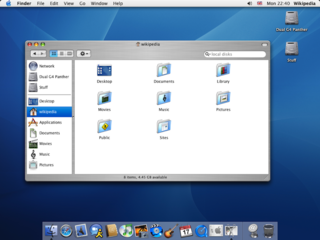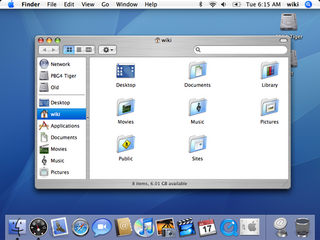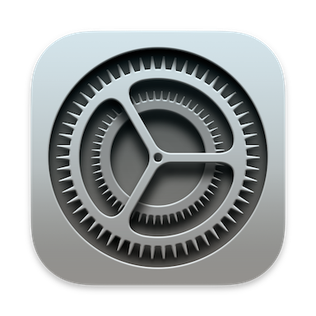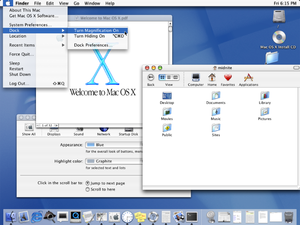
macOS, originally Mac OS X, previously shortened as OS X, is an operating system developed and marketed by Apple since 2001. It is the primary operating system for Apple's Mac computers. Within the market of desktop and laptop computers, it is the second most widely used desktop OS, after Microsoft Windows and ahead of all Linux distributions, including ChromeOS.

Mac OS X Server is a series of discontinued Unix-like server operating systems developed by Apple Inc. based on macOS. It provided server functionality and system administration tools, and tools to manage both macOS-based computers and iOS-based devices, network services such as a mail transfer agent, AFP and SMB servers, an LDAP server, and a domain name server, as well as server applications including a Web server, database, and calendar server.

iBook is a line of laptop computers designed, manufactured, and sold by Apple Computer from 1999 to 2006. The line targeted entry-level, consumer and education markets, with lower specifications and prices than the PowerBook, Apple's higher-end line of laptop computers. It was the first mass consumer product to offer Wi-Fi network connectivity, which was then branded by Apple as AirPort.

Mac OS 9 is the ninth and final major release of Apple's classic Mac OS operating system, which was succeeded by Mac OS X 10.0 in 2001, starting the Mac OS X family of operating systems. Introduced on October 23, 1999, it was promoted by Apple as "The Best Internet Operating System Ever", highlighting Sherlock 2’s Internet search capabilities, integration with Apple's free online services known as iTools and improved Open Transport networking. While Mac OS 9 lacks protected memory and full pre-emptive multitasking, lasting improvements include the introduction of an automated Software Update engine and support for multiple users.
MorphOS is an AmigaOS-like computer operating system (OS). It is a mixed proprietary and open source OS produced for the Pegasos PowerPC (PPC) processor based computer, PowerUP accelerator equipped Amiga computers, and a series of Freescale development boards that use the Genesi firmware, including the Efika and mobileGT. Since MorphOS 2.4, Apple's Mac mini G4 is supported as well, and with the release of MorphOS 2.5 and MorphOS 2.6 the eMac and Power Mac G4 models are respectively supported. The release of MorphOS 3.2 added limited support for Power Mac G5. The core, based on the Quark microkernel, is proprietary, although several libraries and other parts are open source, such as the Ambient desktop.
Macworld/iWorld was an information technology trade show with conference tracks dedicated to Apple's Mac platform. It was held annually in the United States during January. Originally Macworld Expo and then Macworld Conference & Exposition, the gathering dates back to 1985. The conference was organized by International Data Group (IDG), co-publisher of Macworld magazine.

Mac OS X Panther is the fourth major release of macOS, Apple's desktop and server operating system. It followed Mac OS X Jaguar and preceded Mac OS X Tiger. It was released on October 24, 2003, with the retail price of US$129 for a single user and US$199 for a five user, family license.

Mac OS X Jaguar is the third major release of macOS, Apple's desktop and server operating system. It superseded Mac OS X 10.1 and preceded Mac OS X Panther. The operating system was released on August 23, 2002 either for single-computer installations, and in a "family pack", which allowed five installations on separate computers in one household. Jaguar was the first Mac OS X release to publicly use its code name in marketing and advertisements.

Mac OS X 10.1 is the second major release of macOS, Apple's desktop and server operating system. It superseded Mac OS X 10.0 and preceded Mac OS X Jaguar. Mac OS X 10.1 was released on September 25, 2001, as a free update for Mac OS X 10.0 users. The operating system was handed out for no charge by Apple employees after Steve Jobs' keynote speech at the Seybold publishing conference in San Francisco. It was subsequently distributed to Mac users on October 25, 2001, at Apple Stores and other retail stores that carried Apple products.

Mac OS X Tiger is the 5th major release of macOS, Apple's desktop and server operating system for Mac computers. Tiger was released to the public on April 29, 2005 for US$129.95 as the successor to Mac OS X 10.3 Panther. Included features were a fast searching system called Spotlight, a new version of the Safari web browser, Dashboard, a new 'Unified' theme, and improved support for 64-bit addressing on Power Mac G5s. Mac OS X 10.4 Tiger also had a number of additional features that Microsoft had spent several years struggling to add to Windows with acceptable performance, such as fast file searching and improved graphics processing.

Mac OS X Public Beta was the first publicly available version of Apple Computer's Mac OS X operating system to feature the Aqua user interface. It was released to the public on September 13, 2000 for US$29.95. Its release was significant as the first publicly available evidence of Apple's ability to ship the "next-generation Mac operating system" after the Copland failure. It allowed software developers and early adopters to test a preview of the upcoming operating system and develop software for it before its final release. It is the only public version of Mac OS X to have a code name not based on a big cat until the release of 10.9 Mavericks in 2013. The US version had a build number of 1H39 and the international version had build number 2E14.

System Settings is an application included with macOS. It allows users to modify various system settings, which are divided into separate Preference Panes. The System Settings application was introduced in the first version of Mac OS X to replace the control panels found in earlier versions of the Mac operating system.

Stevenote is a colloquial term for keynote speeches given by Steve Jobs, former CEO of Apple, at events such as the Apple Worldwide Developers Conference, Macworld Expo, and Apple Expo. Because most Apple product releases were first shown to the public at these keynotes, "Stevenotes" caused substantial swings in Apple's stock price.

Mac OS X Leopard is the sixth major release of macOS, Apple's desktop and server operating system for Macintosh computers. Leopard was released on October 26, 2007 as the successor of Mac OS X Tiger, and is available in two editions: a desktop version suitable for personal computers, and a server version, Mac OS X Server. It retailed for $129 for the desktop version and $499 for Server. Leopard was superseded by Mac OS X Snow Leopard in 2009. Mac OS X Leopard is the last version of macOS that supports the PowerPC architecture as its successor, Mac OS X Snow Leopard, functions solely on Intel based Macs.

Rosetta is a dynamic binary translator developed by Apple Inc. for macOS, an application compatibility layer between different instruction set architectures. It enables a transition to newer hardware, by automatically translating software. The name is a reference to the Rosetta Stone, the artifact which enabled translation of Egyptian hieroglyphs.

Mac OS X Snow Leopard is the seventh major release of macOS, Apple's desktop and server operating system for Macintosh computers.

Apple Push Notification service (APNs) (previously known as Apple Push Service (APS)) is a platform notification service created by Apple Inc. that enables third party application developers to send notification data to applications installed on Apple devices. The notification information sent can include badges, sounds, newsstand updates, or custom text alerts. It was first launched with iOS 3 on June 17, 2009. APNs support for local applications was later added to the Mac OS X API beginning with the release of Mac OS X 10.7 ("Lion"). Support for website notifications was later added with the release of Mac OS X 10.9 ("Mavericks").

OS X Lion, also known as Mac OS X Lion, is the eighth major release of macOS, Apple's desktop and server operating system for Mac computers.

Mac OS is the series of operating systems developed for the Macintosh family of personal computers by Apple Computer, Inc. from 1984 to 2001, starting with System 1 and ending with Mac OS 9. The Macintosh operating system is credited with having popularized the graphical user interface concept. It was included with every Macintosh that was sold during the era in which it was developed, and many updates to the system software were done in conjunction with the introduction of new Macintosh systems.


















